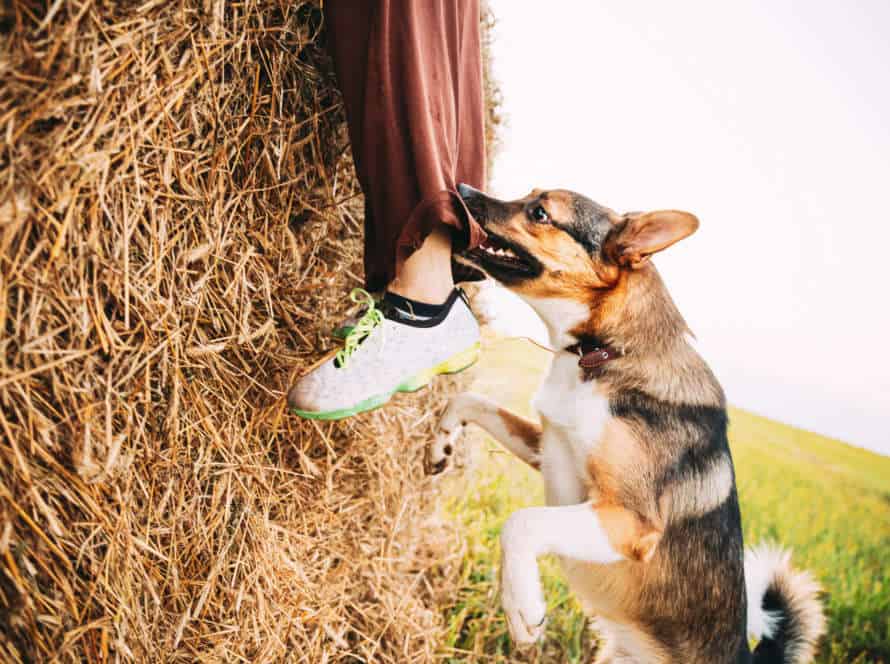The Role of Emotion in Your Dog’s Barking
Dogs bark for different causes. These can include anxiety, fear, excitement, and communication. Emotions are an essential part of their habits. To control and calm the barking, we must address their feelings.
For example, desensitization exercises or medication can help with barking due to anxiety. Positive reinforcement and a safe environment can help with fear. If they are excited, we must give them an outlet for their energy.
As owners, we must learn to read and interpret our dog’s behavior and meet their emotional needs. This is necessary to curb their barking.
Understanding the reasons behind dog barking
Dogs bark to communicate emotions. Fear, aggression, stress, and frustration? These emotions can be expressed through barking. Want to learn what your pup’s bark can mean? Read on for some insights!
We’ll explore the emotions behind your pup’s bark and why they’re feeling them.
Basic communication
Barking is an important way for dogs to communicate. It’s essential to understand why they bark. Here are the top reasons:
- Territorial/Protective: They bark to protect their space from strangers and possible threats.
- Anxiety/Fear: They could bark when scared of a situation or person.
- Attention-Seeking: Could bark for attention from their owners, or to get something like food or playtime.
- Boredom/Loneliness: They may bark out of boredom or loneliness, to pass time or get company.
If you know why your dog is barking, get help from professionals like Barking Royalty to find the right training techniques.
Territorial behavior
Dogs bark for territorial reasons, which is natural. When they feel threatened, they may bark excessively. One way to prevent this is to teach them that visitors aren’t threats.
Understand the emotions behind the barking. Common triggers could be unfamiliar sounds, smells, or people. To stop barking, address the root cause and make the dog feel safe.
To reduce territorial behavior, socialize and train your dog properly.
Anxiety and fear
Anxiety and fear can be behind dog barking. This can be distressing and disruptive – both for the dog and its owners. It’s important to understand what causes the barking and how to address it.
Many dogs bark when they are feeling anxious or scared. This could be because of loud noises, strange situations, or being away from their owners.
To address this type of barking, owners should help their dogs to get used to the things that make them bark. This includes introducing them to these things in a safe and positive way. Over time, this should help the dog to feel more comfortable.
To reach this goal, owners should also give their dog exercise, socialization, and positive reinforcement training. This should help the dog to feel safe and secure and reduce their barking.
The impact of human emotions on dog behavior
Surprise! Research shows that dogs can sense our emotions. And, our emotions affect their behavior – like barking. This article will tell us more about humans’ emotions and how they affect dog behavior.
Anger and frustration
Anger and frustration can have a big effect on a dog’s behavior, including barking. Dogs are very emotional, and pick up on their owner’s emotions. So, when the owner is angry or frustrated, the dog may bark in response.
To prevent this, it’s important to stay calm. Positive reinforcement is best when training a dog. If you feel anger, step away and cool off before continuing with your dog.
Remember, your dog takes in your energy and emotions. It’s vital to give your pup a peaceful and upbeat atmosphere.
Anxiety and worry
Anxiety and worry in humans can have a huge effect on a canine’s actions – like excessive barking. If a pup senses its companion’s anxiousness or concern, it can become scared and bark excessively. Dogs with separation anxiety might bark a lot when left alone, particularly if they pick up on their owner’s tension or worry as they depart.
It’s important to manage your emotions around your doggy to avoid barking. When leaving your furry friend, stay cool and don’t show any signs of stress or worry. Plus, give your pup lots of physical activity and mental stimulation to help reduce anxiety and barking.
For an extra boost, try desensitizing your dog to departure cues by gradually increasing the time away from home and rewarding them for calm behaviour.
Over-excitement
Dogs can be too excited, and this may be due to the emotions of their owners. If people become anxious, scared, or too excited, their pup may react similarly by barking and other behavior.
Here are a few tips on how to handle it:
- -Steady yourself and don’t encourage the over-excitement in your pet.
- -Give your pooch plenty of activities, both mental and physical, to wear out all the energy.
- -Reward good actions with treats and compliments.
- -Set up a quiet environment, avoiding loud noises and sudden movements.
By controlling your feelings and creating a tranquil atmosphere, your pup will learn to relax and not get overly excited. Also, be patient and consistent with your guidance, as dogs may take time to adjust to new rules.
Recognizing emotional states in your dog’s barking
Dogs bark for many reasons – not just aggression! Comprehending the various kinds of barks and their related emotions can help you to respond to your pup more effectively. It is vital to be aware of your dog’s emotional states through their barking, so that you may give them the best care possible.
High-pitched barking
High-pitched barking in dogs can mean many things. From excitement to fear or aggression.
It’s important to observe your pup’s body language to understand what their bark means.
- Excitement? If they are jumping and wagging their tail, with dilated pupils… High-pitched barking could be due to joy.
- Fear? If their body is tense, head lowered, fur standing up… Barking could signify fear.
- Aggression? If the bark is high-pitched and body posture stiff or growling… Aggression could be the source.
If you comprehend your pup’s emotions behind their bark, you can help them and train them better.
Low-pitched barking
Low-pitched barking is often a sign of fear or aggression. Recognizing these emotions can help you better understand your pup. Here’s how to spot their state of mind:
- Low-pitched barking: Deep and guttural. A sign of fear or aggression.
- High-pitched barking: Piercing and shrill. Often indicates excitement, anxiety, or attention-seeking behavior.
- Whining: High-pitched sound. May mean stress, anxiety or frustration.
- Growling: Low, rumbling noise. Could mean fear, territorial behavior, or aggression.
- Pro tip: Also observe your dog’s body language. It can give further insight into their emotions.
Rapid barking
Rapid barking is a common dog behavior. It can show different emotions. It’s important to know your dog’s feeling. Anxious barking is short with pauses in between. Over-excited barking includes jumping, panting and tail wagging. Fearful or protective barking is sharp, too much and repetitive.
The role of emotions in barking is important. It can be fear, anxiety, happiness or aggression. Knowing your dog’s emotions helps you know if it feels safe or scared.
Tip: Dogs bark to express themselves. Watch their body language and surroundings to manage their behavior better.
Managing emotional triggers in your dog’s barking
Dogs bark due to joy or fear. It can be tough to control this kind of barking. Knowing the feelings behind it, and spotting the causes, can help you both relax. Here are tips for dealing with emotional triggers in your pup’s barking:
Positive reinforcement training
Positive reinforcement training is a great way to deal with your pup’s barky behavior. Instead of punishing the barking, reward desired behaviors with treats, praise, and playtime. Here’s how it works:
- Figure out what triggers your pup to bark: fear, anxiety, boredom, or seeking attention.
- Teach your pup simple commands like ‘sit‘, ‘stay‘, and ‘quiet‘.
- Give treats, praises, and belly rubs when they obey.
- Be consistent and patient; no punishment or scolding.
Pro tip: Get help from a pro dog trainer or behaviorist to make a personalized plan for your pup.
Distraction and redirection
To manage your pup’s barking behaviors, distraction and redirection can be helpful techniques.
Identify the trigger that makes your pooch bark, such as a guest or an unfamiliar sound.
Turn their attention to something else, like a toy or a snack. This can help take their mind off the trigger.
Reward your pup after they stop barking and focus on something else – like with some kind words or a small treat.
With practice, they’ll connect the trigger with positive experiences rather than barking.
Remember, distraction and redirection won’t work for every pup and situation. If their barking continues, try getting help from a professional dog trainer.
Counter-conditioning
Counter-conditioning is a good way to manage your dog’s barking reactions.
Do this:
- Figure out what sets off the barking (e.g. doorbell/visitor).
- Connect it with positive rewards (treats, toys).
- Every time the trigger happens, give a reward.
- Do this regularly, increasing the space between trigger and reward.
- With regular practice, they’ll learn to control barking and stay calm.
Pro Tip: Consistency is essential. Follow a training plan and be patient with your pup.
Seeking professional help for dog behavior issues
Dogs bark for multiple reasons, yet excessive barking can show underlying emotional problems. If this is the case, getting support from a vet or certified animal behaviorist is beneficial.
What can a professional do? Let’s find out!
Consulting a professional dog trainer
Is your pup showing behavior issues that you can’t seem to fix? Consulting a professional dog trainer may be beneficial. They can bring insight and tactics to help you train your furry friend, and manage their problematic behavior.
A key factor to think about is emotion linked to barking. Dogs bark due to anxiety, fear, excitement, boredom, or territorial behavior. A professional trainer can help you identify the root cause and work with you to address it.
With the help of a trainer, you can construct a training plan that fits your dog’s unique behavior and attitude. This will help ensure long-term success.
Pro Tip: Look for a trainer who uses positive reinforcement-based training methods and has a successful track record.
Seeking advice from a veterinary behaviorist
Tackling dog behavior issues can be tricky. Seeking help from a veterinary behaviorist is an effective way to fix these problems. A veterinary behaviorist is a professional who focuses on animal behavior and psychology, and has the knowledge to diagnose and manage pet behavioral issues.
If your dog barks too much, a veterinary behaviorist can analyze your dog’s behavior and uncover the possible emotional and medical factors. Fear, anxiety, or excitement could be causing the excessive barking, and the behaviorist can help you understand how these emotions factor into the behavior. Plus, the behaviorist can suggest interventions and training techniques tailored to your dog’s needs.
Getting help from a veterinary behaviorist is the first step to improving your dog’s behavior and strengthening the bond between you and your pet.
Pro tip: Look for a board-certified veterinary behaviorist with experience in treating your particular issue.
Considering medication for anxiety and fear-based behaviors.
Is your pup displaying anxious and fearful behavior? Perhaps it’s time to think about medicating them. Though, this shouldn’t be the first choice. It can help when paired with other treatments. Here are some reasons why medication might be a good idea:
- No response to behavior training
- The pup and owner are both distressed
- Extreme anxiety or uncontrollable fear
It’s key to work with a vet or vet behaviorist to choose the best medication and dose for your pup. There are some options, such as SSRIs and tricyclic antidepressants, to help manage anxiety and fear in dogs. Here’s a tip: Medication isn’t a magical cure for behavior issues in dogs. It should be used with behavioral training and management techniques for better results.
Frequently Asked Questions
What role do emotions play in my dog’s barking?
Emotions can have a significant impact on why and how much your dog barks. For example, anxiety, fear, and boredom can all lead to excessive barking, and excitement or playfulness may also increase barking.
How can I tell what emotions my dog is experiencing when they bark?
There are various clues that can give insight into your dog’s emotional state when they bark, including the tone and pitch of the barking and the body language your dog exhibits while barking. Pay attention to other cues such as ear and tail position and overall body posture.
What can I do to help my dog if their barking is driven by negative emotions?
There are various approaches to managing barking that is driven by negative emotions, including addressing the underlying cause of the emotion, using positive reinforcement training to teach your dog new behaviors, and providing mental and physical stimulation to reduce anxiety and boredom.
Is it possible for my dog to bark excessively because of positive emotions?
Yes, many dogs bark excessively when they are excited or happy, such as when they see their favorite person or are getting ready for a walk. While this type of barking is generally less concerning than other types, it can still be problematic if it becomes excessive or bothersome to neighbors.
Can I train my dog to bark less in response to certain situations?
Yes, with the proper training, many dogs can learn to bark less in response to certain stimuli, such as visitors at the door, other dogs, or loud noises. Consistency, patience, and positive reinforcement are key components of effective barking training.







